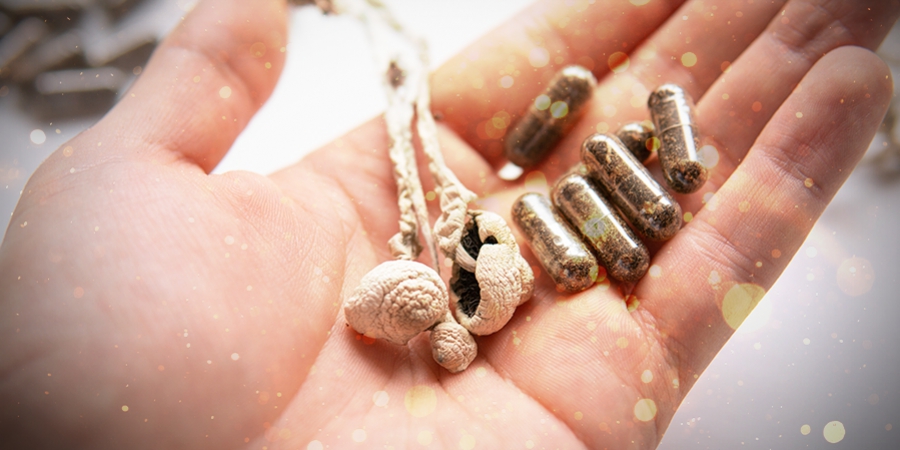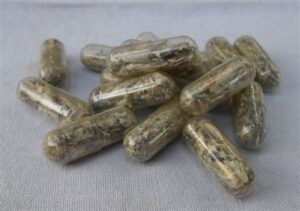Commonly given to psychoactive fungi, containing hallucinogenic compounds, most commonly psilocybin and psilocin. At low doses, hallucinogenic drugs have as their primary effects perceptual distortions and alterations of thought, or mood, with the presence of lucid awareness and minimal effects on memory and orientation. Despite their name, the use of hallucinogenic drugs rarely results in true hallucinations. The hallucinogens are a chemically diverse class. Grouping the hallucinogens based on their chemical structure includes, but is not limited to, three major classes: indolealkylamines or tryptamines (e.g. LSD, psilocybine and psilocin), phenethylamines, including mescaline and methylenedioxymethamphetamine (MDMA); and cannabinoids.
Chemistry
Psilocybin (PY, 4-phosphoryloxy-N,N-dimethyltryptamine) is the main psychoactive principle of hallucinogenic mushrooms. After ingestion, psilocybin is converted into the pharmacologically active form psilocin. Psilocin itself is also present in the mushroom, but in smaller amounts. Psilocybin and psilocin are both indolealkylamines and structurally similar to the neurotransmitter serotonin (5-hydroxytryptamine or 5-HT). Besides psilocybin and psilocin, two further tryptamines — baeocystin and norbaeocystin — could also be present but are thought to be less active than the former two.
Psilocybin (psilocybine, psilocibina, psilocybinum, psylosybiini) (CAS-number: 520-52-5) is 4-phosphoryloxy-NN-dimethyltryptamine. According to IUPAC, the fully systematic chemical name is [3-(2-dimethylaminoethyl)-1H-indol-4-yl] dihydrogen phosphate. Psilocybin is the dihydrogen phospate of psilocin. Psilocybin is soluble in water, moderately soluble in methanol and ethanol, and insoluble in most organic solvents. Psilocybin is a prodrug of psilocin, in vivo the molecule is metabolised into psilocin by dephosphorylation.
Molecular structure of psilocybin

Molecular formula: C12H17N204P
Molecular weight: 284.3 g/mol
Psilocin (psilocine, psilocyn) (CAS-number 520-53-6) is 4-hydroxy-NN-dimethyltryptamine (4-OH-DMT) or alternatively 3-(2-dimethylaminoethyl)indol-4-ol. According to IUPAC, the fully systematic chemical name is 3-(2-dimethylaminoethyl)-1H-indol-4-ol. Psilocin is an isomer of bufotenine, it differs only in the position of the hydroxylgroup. Psilocin is relatively unstable in solution. Under alkaline conditions in the presence of oxygen it immediately forms bluish and black degradation products.
Molecular structure of psilocin

Molecular formula: C12H16N20
Molecular weight: 204.3 g/mol
Physical form
Hallucinogenic mushrooms are available in fresh form, treated/preserved (e.g. deliberately dried, cooked, frozen) or even as dry powders or capsules.
The fungi containing psilocybin and psilocin mainly belong to the genuses Psilocybe, Panaeolus and Copelandia and their number exceeds 50 species. Most of the mushrooms containing psilocybin are small brown or tan mushrooms. In the wild, these mushrooms are easily mistaken for any number of non-psychoactive, inedible, or poisonous mushrooms. This makes them difficult, and potentially hazardous, to identify.
Because it is difficult to distinguish non-psilocybin species from the hallucinogenic mushrooms ones by morphological observation in the wild, psilocybin-containing mushrooms may also be easily ingested unintentionally. Hallucinogenic mushrooms resemble the common store mushroom Agaricus bisporus, although the flesh of Psilocybe mushrooms characteristically turns blue or green when bruised or cut. An identification method based on a genetic approach has been developed.
A different species of mushroom, Amanita muscaria (fly agaric), produces a state of delirium that also includes hallucinations, but its primary active agents are muscimol and ibotenic acid.
Pharmacology
Psilocin mainly interacts with 5-HT1A, 5-HT2A and 5-HT2C receptor subtypes: it is a mixed receptor agonist. In contrast to LSD, psilocin does not have an effect on the dopamine receptor. Tryptamines and phenethylamine hallucinogens both have a relatively high affinity for serotonin 5-HT2 receptors, but they differ in their affinity for other subtypes of serotonin receptors.
The correlation between the relative affinity of hallucinogens for 5-HT2-receptors and their potency as hallucinogens in human beings suggest that an important component of the mechanism of action of these substances is through stimulation of brain 5-HT2-receptors. A primary role for the 5-HT2-receptor in the mechanism of hallucinations is further suggested by the observation that antagonists of the 5-HT2-receptor are effective in blocking the behavioural and electrophysiological effects of hallucinogenic drugs in animals and in man. Although 5HT2-receptors are certainly involved, at present, it is not possible to attribute the psychedelic effects to any single 5-HT receptor subtype.
Behavioural effects are dependent on dose and the individual reaction and sensitivity to psilocybin, previous experiences and the setting. The major effects are related to the central nervous system, but there are also some sympathomimetic effects. The subjective effects, however, may vary greatly between individuals and from one episode of use to the next within the same person.
The effects range from mild feelings of relaxation, giddiness, euphoria, visual enhancement (seeing colours brighter), visual disturbances (moving surfaces, waves), to delusions, altered perception of real events, images and faces, or real hallucinations. The sensory distortions may be coupled with restlessness, incoordination, feelings of anxiety, impaired judgement of time or distance, sense of unreality or even depersonalisation. These effects may be termed ‘bad trips’ by users and can also involve panic reactions and psychosis-like states.
In general, the physiological effects are not significant, but may include dizziness, nausea, weakness, muscle aching, shivering, abdominal pain, dilation of pupils (mydriasis), mild-to-moderate increase in heart rate (tachycardia) and breathing (tachypnea) and elevation of blood pressure. Generally, body temperature remains normal. However, pronounced physical symptoms such as severe stomach pain, persistent vomiting, diarrhoea etc. have been recorded.
Origin
Both psilocybin and psilocin can be produced synthetically, but this form of the drug is not often found. Users purchase hallucinogenic mushrooms and by-products from smartshops and on the Internet, or pick them wild. The cubensis varieties are cultivated specifically (mostly in the Netherlands). The types of magic mushrooms most commonly sold by smartshops in the Netherlands are the Psilocybe cubensis varieties.
Online shops sell a variety of hallucinogenic mushroom products ranging from fresh mushrooms to spore prints, spawnbags and growkits. The majority of online shops offer international shipping, although most sites do not ship to countries where sales are prohibited.
Mode of use
Recreational doses range from 1–5 grams of dry mushrooms depending on the species and individual strength of the specimens. Dosages for fresh mushrooms will be approximately 10 times higher (10–50 grams). The material may be eaten raw, boiled in water to make tea, or cooked with other foods to cover its bitter flavour. After ingestion, the psilocybin is enzymatically converted to psilocin. Absorbed from the gastro-intestinal tract, hallucinogenic effects usually occur within 30 minutes of ingestion with a duration of effect of 4–6 hours.
Other names
Common names in the English language are: shrooms; magic mushrooms; sacred mushrooms; teonanácatl. Various terms have also been used by users for various forms of psilocybin and psilocin or mushrooms containing these hallucinogens: blue caps; boomers; booms; buttons; caps; champ; fungus; funguys; God’s flesh; hombrecitos; las mujercitas; little smoke; Mexican mushroom; mushies; mushroom soup; mushroom tea; mushrooms; musk; pizza toppings; rooms; silly putty; simple Simun; zoomers (Martindale, 2007).
Translations of ‘hallucinogenic mushrooms’ in European languages include:
Bulgarian — ‘магически гъби’; Czech — ‘magické houby’; Danish — ‘psilocybinsvampe’, ‘magiske svampe’; Estonian — ‘hallutsinogeense toimega seened’; Greek — ‘μαγικά μανιτάρια’; French — ‘champignons hallucinogènes’ or ‘champis’; German — ‘Psychoaktive Pilze’ or ‘Zauberpilze’; Hungarian — ‘varázsgombák’, ‘hallucinogén gombák’, ‘pszilocibingombák’; Italian — ‘funghi magici’; Latvian — ‘Halucinogēnās (maģiskās) sēnes’; Lithuanian — ‘haliucinogeniniai grybai’, ‘magiškieji grybai’; Norwegian — ‘fleinsopp’; Polish — ‘magiczne grzybki’, ‘grzyby halucynogenne’; Portuguese — ‘cogumelos mágicos’, ‘cogumelos psicadélicos’; Slovakian — ‘magické huby’; Slovenian — ‘čudeţne gobe’; Spanish — ‘hongos alucinógenos’, ‘hongos lisérgicos’, ‘honguitos’; Romanian — ‘ciuperci halucinogene’; Swedish — ‘magiska svampar’, ‘psykedeliska svampar’.
Control status
Psilocin and psilocybin are controlled substances under Schedule I of the United Nations 1971 Convention on Psychotropic Substances. However, the control of the mushrooms that contain these substances is interpreted in many different ways across Europe. Probably this reflects the extent to which they grow freely in certain conditions, and the fact that they appear to be a somewhat regional phenomenon.
For example, in some European countries, the law specifically lists hallucinogenic mushrooms themselves as a controlled substance and forbids their sale or possession. Other countries simply treat the mushrooms as being the controlled substances of psilocin or psilocybin in compound form. Some look at the intent of the act; they ban cultivation, possession or sale only when for the purposes of abuse.
Their condition is also considered — fresh mushrooms might not be considered illegal, but prepared or treated mushrooms are illegal — again perhaps reflecting the intent. Interpretation of the term ‘prepared’ or ‘treated’ is a complex matter for the courts. Other countries use a catch-all phrase in the law (‘cultivation of any plant for the purposes of making a psychoactive substance’). Finally, a number of countries remain with unclear legislation, simply as there have been so few cases that have come to court.
Medical use
In the 1960s, pure synthetic psilocybin was marketed by Sandoz for experimental and psychotherapeutic purposes. At present, there are no medical indications for psilocin or psilocybin. Recent research with psilocybin has been reported on the treatment of compulsive disorders in humans.
In the past few years, a growing number of studies using human volunteers have begun to explore the possible therapeutic benefits of drugs such as psilocybin, LSD, DMT, MDMA, ibogaine and ketamine. These studies are looking at psilocybin and other hallucinogenic mushrooms to treat a number of otherwise intractable psychiatric disorders, including chronic depression, post-traumatic stress disorder, and drug or alcohol dependency.

